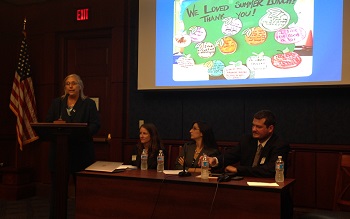Park and recreation agencies are located in almost every community across the country and are the largest public provider, outside of schools, for United States Department of Agriculture-funded feeding programs. These initiatives provide healthy meals and snacks to children in low-income areas during out-of-school times. For many children, these may be the only nutritious meals they enjoy on a normal day. It is vital in communities across the country to continue funding for the Summer Food Service Program and Child and Adult Care Food Program, which will be addressed by Congress in the Child Nutrition Act Reauthorization next fall.
With Congress currently out of session, senior officials have a prime opportunity to learn more about some of the important issues for parks and recreation. NRPA recently co-sponsored a congressional briefing with the Food Research and Action Center, Afterschool Alliance, YMCA of the USA and The Boys and Girls Clubs of America to educate policymakers and advocates on the Child Nutrition Act reauthorization and the critical role of after school meal programs and summer nutrition programs that provide food for hungry children when school is out.
 We were fortunate to have Terri Kerwawich, program director with Philadelphia Parks and Recreation (PPR), join us as a speaker at the D.C. briefing. Leaders were able to hear directly from Kerwawich and ask questions about how these programs provide nutritious meals and snacks while engaging children in educational and enrichment activities and programs.
We were fortunate to have Terri Kerwawich, program director with Philadelphia Parks and Recreation (PPR), join us as a speaker at the D.C. briefing. Leaders were able to hear directly from Kerwawich and ask questions about how these programs provide nutritious meals and snacks while engaging children in educational and enrichment activities and programs.
PPR’s food service program has a longstanding history of providing meals to the city’s children who may otherwise go hungry. It has been in operation for more than 40 years, serving a population of children that continues to increase annually. During the 2013-14 school year, PPR ran 109 after-school sites and served 412,000 suppers. To top that off, in the summer of 2014, Philadelphia had 869 sites and served more than 2.6 million meals. The summer food programs were held at PPR facilities, independent sites (churches, community organizations and camps) and playstreets (neighborhood-based programs where children can receive a healthy meal and snack without leaving the street on which they live). PPR is also part of NRPA’s Commit to Health campaign, which supports the implementation and evaluation of Healthy Eating, Physical Activity (HEPA) standards in park and recreation sites across the country. Hearing these impressive statistics and stories directly from park and recreation leaders like Kerwawich resonates in a powerful way with congressional leaders who work on the legislation that supports feeding programs.
Park and recreation leaders lend a powerful voice to the advocacy campaign supporting federally funded feeding programs. You can help by sharing examples from your agency that highlight the great work being done to facilitate local food programs.
Next year, Congress will have to address the Child Nutrition Act, which authorizes funding for the Summer Food Service Program and Child and Adult Care Program and expires in September. This is the moment to build support for these important programs and share your community’s story with your Congressional members.
As we head into the holiday season and NRPA ramps up advocacy efforts in D.C., now is the perfect time to educate national leaders about the essential role park and recreation agencies play in the fight against hunger.
What story would you tell your Congressional members about? Share in the comments below.
Sage Learn is NRPA's Government Affairs Manager.
Updated: Nov. 12, 2014

